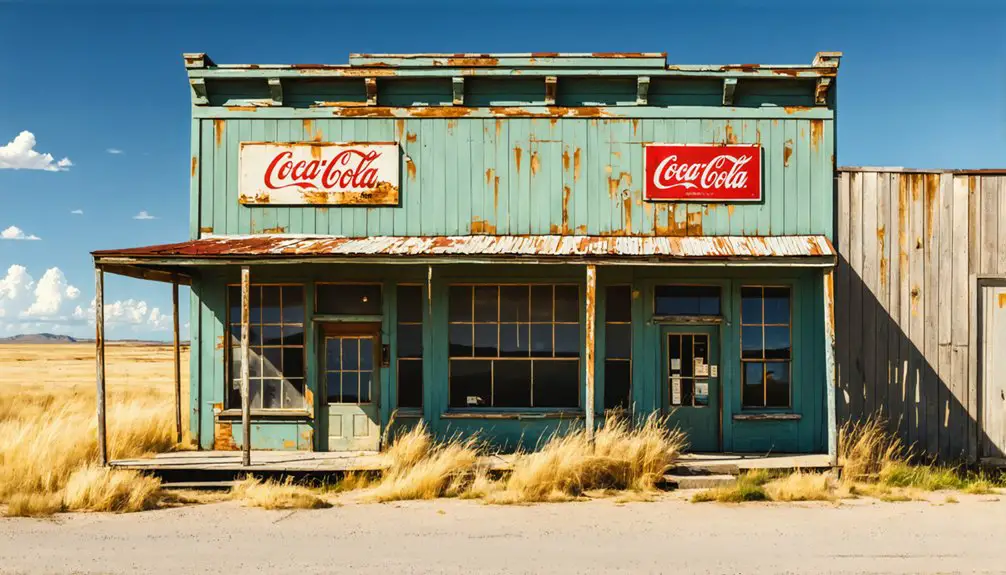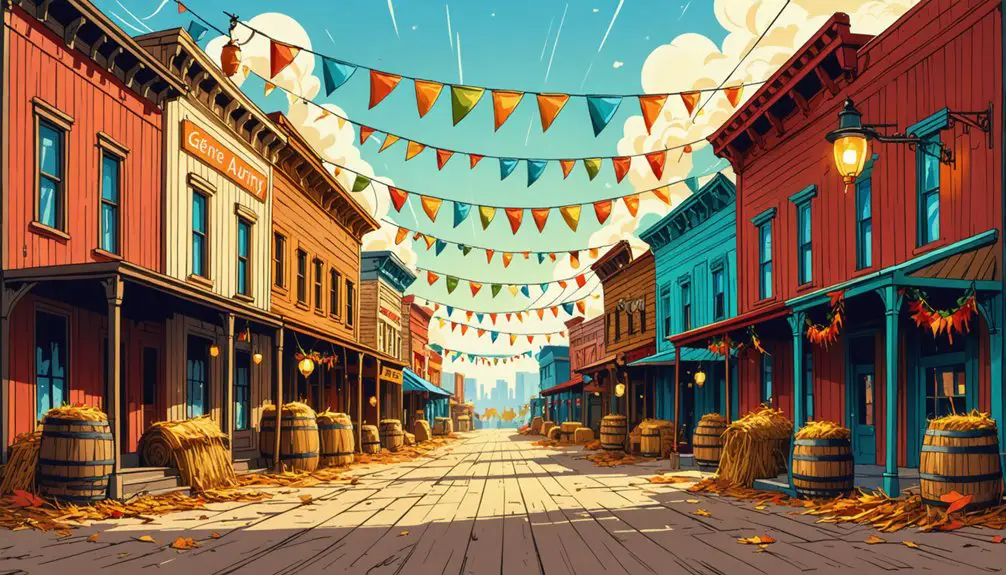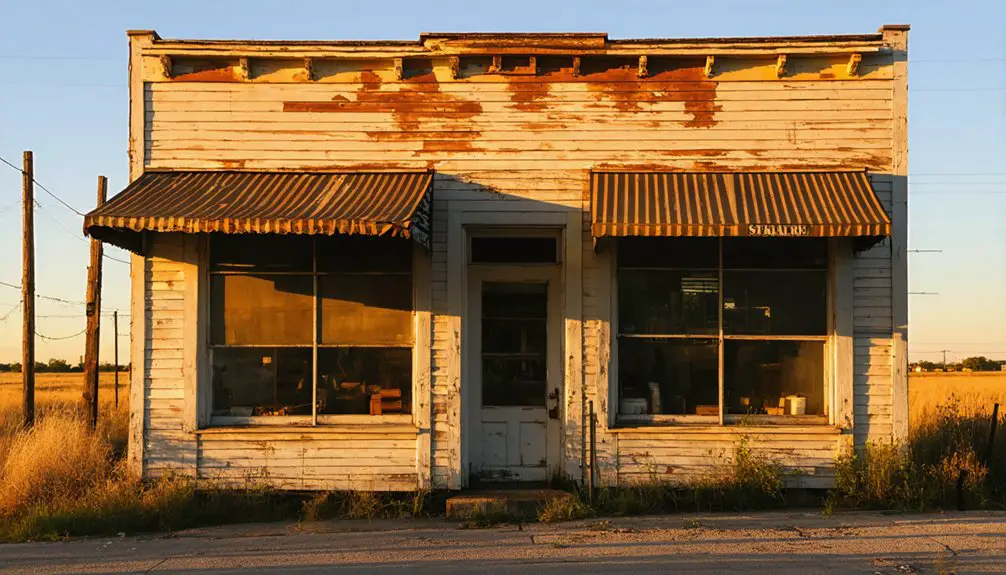You’ll discover Gene Autry, Oklahoma, as a striking example of the American West’s rise and fall. Originally named Berwyn, this agricultural hub reached its peak in 1920 with 435 residents before the Dust Bowl devastated local farms. The town’s famous namesake, singing cowboy Gene Autry, bought the Flying A Ranch here in 1939, prompting the town’s renaming in 1941. Today, with fewer than 150 residents, its quiet streets and abandoned buildings tell a fascinating story of transformation.
Key Takeaways
- Gene Autry’s population declined over 80% from its 1920 peak of 435 residents due to the Great Depression and Dust Bowl.
- Once-thriving businesses, including cotton gins, feed mills, and banks, closed as residents fled failing farms during economic hardship.
- The town transformed from a bustling agricultural hub to a bedroom community, with most residents now commuting to nearby Ardmore.
- Despite its near-ghost town status, the Gene Autry Oklahoma Museum preserves local history in a former school building.
- The town’s decline began during World War II after Gene Autry enlisted and sold his Flying A Ranch in 1946.
The Birth of Berwyn: Early Settlement Years
While the area east of present-day Gene Autry had scattered inhabitants throughout the 1870s, formal settlement didn’t begin until 1883 when a store and post office named Lou emerged within the Chickasaw Nation’s Indian Territory.
Within months, the settlement’s name changed to Dresden, but this location wouldn’t last long. In 1887, when the Gulf, Colorado and Santa Fe Railway bypassed Dresden, you’d have witnessed a dramatic shift in settlement patterns as residents moved their entire community to the railroad tracks. Like the nearby town of Cherokee Crossing, Dresden’s residents recognized the vital importance of being near rail transportation.
When the railroad bypassed Dresden, the townspeople simply packed up and moved their entire community closer to the tracks.
The railroad company, following its practice of naming towns after Pennsylvania locations, christened the new settlement Berwyn.
This strategic relocation transformed what had been a simple trading post into a proper town, though early settlers faced significant agricultural challenges in taming the frontier. The town gradually grew into a bustling community with two cotton gins, providing essential services for local farmers.
From Berwyn to Gene Autry: A Historical Transformation
As economic hardship gripped Oklahoma during the Great Depression, the small town of Berwyn made a bold bid for revival by adopting the name of America’s beloved “Singing Cowboy.”
On November 16, 1941, an extraordinary crowd of 35,000 people gathered to witness the town’s official transformation into Gene Autry, Oklahoma, during a ceremony that featured both the famous entertainer himself and Governor Leon Phillips.
The renaming significance went beyond mere symbolism. Autry’s recent purchase of the nearby 1,200-acre Flying A Ranch in 1939 had given locals hope for economic resurgence. His success as the Columbia Records star had already made him a household name across America.
You’d have heard the live broadcast of the ceremony on Autry’s Melody Ranch radio show, marking a defining moment in the community’s identity.
Despite initial optimism, World War II changed everything when Autry enlisted in 1942, later selling the ranch and leaving the town’s dreams unfulfilled. The Ardmore Air Force Base was constructed nearby that same year, providing some employment opportunities for local residents.
The Golden Era of Agriculture and Commerce
During the early twentieth century, Gene Autry – then known as Berwyn – thrived as a bustling agricultural hub with impressive commercial infrastructure.
You’d find cutting-edge agricultural innovations including two cotton gins, a feed mill, and a grain elevator that served the region’s farmers. The town’s bank and various stores supported a vibrant trading economy centered on cotton and grain production.
The community’s spirit came alive during weekend gatherings, when farmers and workers would flock to town for entertainment and socializing. The town would later honor its namesake when 35,000 spectators attended the gala celebration marking its name change from Berwyn to Gene Autry. In 1941, the town officially became Gene Autry, Oklahoma, after the famous singing cowboy established his ranch nearby.
With a peak population of 435 around 1920, you’d experience a lively “Saturday night town” atmosphere complete with restaurants, bars, and dances.
This golden era showcased the perfect blend of agricultural prosperity and social significance that defined early twentieth-century rural Oklahoma.
Dust Bowl Impact and Population Decline
Once the Great Depression struck in the 1930s, Gene Autry’s agricultural prosperity gave way to devastating environmental and economic hardship.
The Dust Bowl‘s massive storms ravaged the region, stripping away precious topsoil and decimating crop yields. You’d have witnessed the town’s lifeblood – its farming community – crumble as the land became increasingly infertile.
A dramatic population exodus followed as residents fled their failing farms. From its peak of 435 people in 1920, the town’s numbers plummeted. Many residents joined the mass migration to urban areas as rural communities across Oklahoma declined.
One by one, local businesses shuttered: feed mills went quiet, cotton gins stopped running, and banks closed their doors.
Even the town’s renaming to Gene Autry in 1939 couldn’t stem the tide of decline, as families continued seeking opportunities elsewhere, leaving behind empty buildings and fading dreams. Today, the free museum admission helps preserve the town’s cultural heritage through its extensive Western film memorabilia.
The Flying A Ranch Legacy
The Flying A Ranch‘s 1,200 acres west of Berwyn served as the central hub for Gene Autry‘s touring rodeo operations, which he managed until merging with Everett Colborn’s World Championship Rodeo in 1942.
A Meyers Photo Shop photograph captured Autry exploring the ranch’s scenic landscape near a pond during that pivotal November of 1941.
You’d often find the ranch bustling with celebrity guests and entertainment industry figures during major events, including the historic November 1941 ceremony where 35,000 people gathered to witness the town’s renaming.
The famous performer later became known for hits like Back in the Saddle Again and numerous other Western classics during this period.
While the ranch’s presence brought significant economic activity and national attention to the area during its brief heyday, Autry’s enlistment in World War II and subsequent sale of the property in 1946 marked the end of this remarkable chapter in local history.
Ranch Operations and Management
Founded in November 1941, Gene Autry’s Flying A Ranch sprawled across 1,200 acres west of Berwyn, Oklahoma, serving as both a pivotal rodeo headquarters and a tribute to Western entertainment innovation.
Under Autry’s ranch management practices, the Flying A Ranch Rodeo quickly became one of America’s largest and most influential rodeo promoters, setting new standards for competitive events and prize money.
You’d have witnessed a remarkable transformation in rodeo event standards, as the ranch focused on improving livestock quality and entertainment value.
The operation merged with the World Championship Rodeo Corporation in 1942, creating a powerhouse in the industry.
The ranch’s commitment to excellence showed in every detail, from carefully managed livestock to spectacular production values that kept audiences coming back for more.
Celebrity Gatherings and Events
Beyond its impressive ranch operations, Flying A Ranch emerged as a magnetic hub for celebrity gatherings and entertainment spectacles throughout the 1940s.
You’d find Gene Autry‘s star power drawing crowds of up to 35,000 people, transforming this Oklahoma destination into a crossroads of Western entertainment and rodeo culture.
The ranch’s celebrity influence peaked when Autry merged his rodeo operations with the World Championship Rodeo Corporation, attracting film stars and radio personalities to its events.
During broadcasts of Autry’s “Melody Ranch” radio show, featuring talents like Virginia Vass, the ranch’s prominence grew even further.
Rodeo performances blended seamlessly with celebrity appearances, creating a unique atmosphere where competitive sports met Hollywood glamour, establishing Flying A Ranch as the epicenter of Western entertainment.
Local Economic Impact
During Gene Autry’s crucial 1939 acquisition of the 1,200-acre Flying A Ranch, you’d witness a remarkable transformation of Berwyn’s economic landscape. His investment brought immediate significance to local business, creating jobs in ranch operations and drawing visitors from surrounding communities.
The ranch’s presence as a rodeo headquarters injected essential capital into the region during the challenging Great Depression era.
- You’d see packed weekend streets as farming families flocked to town, filling local shops
- You’d find new employment opportunities in ranch facilities and stock management
- You’d notice increased commerce from the 35,000 visitors during the 1941 renaming celebration
- You’d experience the town’s brief golden age of economic sustainability
However, this prosperity proved temporary, as Autry’s 1946 sale of the ranch led to gradual economic decline.
Cultural Landmarks and Museum Heritage

You’ll find the Gene Autry Oklahoma Museum standing as the town’s cultural cornerstone, housing the world’s largest collection of vintage cowboy entertainment memorabilia from the 1920s onward.
The museum’s origins trace back to local efforts preserving the legacy of America’s beloved “Singing Cowboy” through an extensive array of artifacts, including musical instruments, movie posters, and personal effects.
As you explore the museum’s exhibits, you’ll discover how this institution serves both as a tribute to Gene Autry‘s impact on American entertainment and as an essential repository of Western heritage that continues to educate visitors about the Cowboy Way of Life.
Museum Origins and Evolution
The Gene Autry Oklahoma Museum emerged in 1990 when the town repurposed an empty former school building from its Berwyn days into a cultural institution dedicated to preserving the legacy of singing cowboys from “B” Westerns.
The museum’s significance extends beyond its walls, serving as a powerful symbol of community identity since the town’s 1941 renaming to honor their distinguished neighbor, Gene Autry.
- You’ll discover an impressive collection of Autry’s personal artifacts, from his cherished musical instruments to rare movie memorabilia.
- You’re transported back to the golden age of Western films through authentic exhibits and cultural displays.
- You’ll experience the spirit of the American West through annual events like the Oklahoma Jamboree.
- You’re connecting with a living piece of history that continues to inspire Western heritage preservation.
Preserving Entertainment History
Since its 1941 renaming ceremony that drew 35,000 attendees, Gene Autry, Oklahoma has served as a living monument to America’s Western entertainment heritage.
You’ll find the cultural preservation efforts centered around the Gene Autry Oklahoma Museum, housed in the repurposed Berwyn school building, where the legacy of “B” Westerns and singing cowboys lives on.
The town’s entertainment legacy includes the historic Flying A Ranch, featuring original structures adorned with Autry’s iconic Flying A logo.
Local celebrations like the Film and Music Festival and Oklahoma Jamboree continue to honor this rich heritage.
The museum’s collection and programming attract Western Americana enthusiasts and scholars, while dedicated volunteers and civic groups maintain these crucial connections to the town’s entertainment roots through year-round cultural activities.
Local Culture on Display
Standing as a tribute to Western entertainment heritage, Gene Autry Oklahoma Museum anchors the town’s cultural identity within its rustic, knotty pine walls.
You’ll discover the nation’s largest private B-Western collection, where local storytelling comes alive through cultural artifacts spanning decades of cowboy entertainment. The museum’s free admission policy guarantees everyone can explore this monument to American freedom and frontier spirit.
- Authentic cowboy gear including vintage saddles and six-guns that transport you to the untamed West
- Rare memorabilia from legendary singing cowboys like Gene Autry, Roy Rogers, and Tex Ritter
- Historic comic books and movie posters that capture the golden age of Western entertainment
- Immersive exhibits showcasing the evolution of cowboy media from radio to YouTube
Annual Festivals and Community Events

Located in the heart of Oklahoma’s Western heritage corridor, Gene Autry’s signature annual event, the Gene Autry Oklahoma Film and Music Festival, has drawn enthusiasts and collectors since its 1990 establishment.
Festival highlights include Western and country music performances, memorabilia auctions, and interactive Q&A sessions with special guests. The town’s repurposed school building, now serving as the Gene Autry Oklahoma Museum, anchors these celebrations with exhibits of film artifacts, musical instruments, and historical treasures.
Community engagement flourishes through local volunteer participation, traditional food offerings, and educational programming about Western film history.
You’ll find the festival’s family-friendly atmosphere creates a reunion-like experience for fans, while the museum serves as a cultural hub preserving Gene Autry’s enduring legacy in American Western heritage.
Economic Evolution and Modern Challenges
When Berwyn was at its economic peak in 1920, the town’s 435 residents enjoyed a thriving agricultural economy built around cotton gins, a feed mill, grain elevator, and flour warehouse.
You’ll find that this rural sustainability didn’t last, as the Great Depression and Dust Bowl devastated local farming.
Gene Autry’s 1939 purchase of the Flying A Ranch briefly sparked hopes for economic diversification, drawing 35,000 visitors for the town’s renaming celebration in 1941.
- Your town’s fate shifted dramatically when agricultural decline forced families to seek opportunities elsewhere
- You’d have seen most businesses shuttered by 1970, leaving only a grocery store and post office
- Your community’s population plummeted over 80% from its peak
- You’re now part of a bedroom community, with most residents commuting to nearby Ardmore for work
Geographic Significance in Carter County
You’ll find Gene Autry strategically positioned in eastern Carter County, just south of State Highway 53 and approximately 17 miles northeast of Ardmore.
The town’s location proved essential for transportation, as the Gulf, Colorado and Santa Fe Railway’s 1887 arrival prompted the community to relocate closer to the tracks from its origins near a Chickasaw Nation trading post.
The town’s placement at this railway junction enhanced its role in regional commerce while maintaining its historical connection to Chickasaw Territory, where the original trading post had operated since the 1870s.
Strategic Transportation Hub Location
The strategic positioning of Gene Autry within Carter County’s transportation network emerged from a crucial decision in 1887, when the town, then known as Berwyn, deliberately relocated to align with the Gulf, Colorado and Santa Fe Railway.
You’ll find the town’s transportation infrastructure masterfully integrated both rail and roadway systems, creating a essential hub for agricultural commerce. The rail road symbiosis propelled economic growth, with nearby Ardmore’s connections to Oklahoma City, Kansas City, and Chicago amplifying regional reach.
- You could’ve witnessed cotton and grain flowing through two bustling cotton gins and grain elevators
- You’d have seen freight trains carrying the community’s lifeblood to distant markets
- You might’ve caught Gene Autry himself broadcasting from a flatcar in 1941
- You’d have experienced the freedom of movement along State Highway 53’s strategic corridor
Historic Chickasaw Territory Significance
Prior to Gene Autry’s establishment, this land held deep significance as an essential part of the Chickasaw Nation‘s territory within Pickens County.
You’ll find this area was part of the Chickasaw’s 7,267-square-mile homeland, secured through the 1837 Treaty of Doaksville when they leased western Choctaw lands for $530,000. The territory’s rich plains supported the Chickasaw’s thriving agricultural endeavors, while its strategic position between the Canadian and Red Rivers made it crucial for trade and transportation.
The land’s Chickasaw heritage runs deeper than just boundaries – it’s where the nation built its social infrastructure after separating from the Choctaw in 1855.
Archaeological findings reveal 83 sites in Carter County, showing how this region’s cultural preservation spans thousands of years of indigenous history.
The Town’s Connection to Entertainment History
While many small towns fade into obscurity, Gene Autry, Oklahoma stands as a unique tribute to America’s golden age of Western entertainment. When the “Singing Cowboy” purchased the Flying A Ranch in 1939, he sparked an entertainment legacy that transformed this rural community.
You’ll find the town’s connection to show business cemented in 1941, when 35,000 people gathered to celebrate its renaming from Berwyn to Gene Autry, complete with a live CBS radio broadcast. The local community pride swelled as their town became synonymous with Western heritage.
- The stone stables with Flying A logos still stand as silent sentinels to the ranch’s glory days
- Gene Autry’s personal connection ran deep – he once worked here as a young telegraph operator
- The Gene Autry Museum preserves precious artifacts from the Western entertainment era
- Melody Ranch’s influence stretched from Oklahoma to California, shaping Western film history
Frequently Asked Questions
Does Gene Autry Still Own Property in the Town Today?
No, you won’t find Gene Autry’s legacy reflected in current property ownership there. He passed away in 1998, and there’s no evidence his estate maintains any holdings in the Oklahoma town bearing his name.
What Happened to Gene Autry’s Original Flying a Ranch Buildings?
You won’t find any original structures today – after Autry sold the Flying A Ranch in 1946, the historical significance faded as buildings deteriorated and were demolished during the land’s subdivision into farming parcels.
Are There Any Descendants of Original Berwyn Settlers Still Living There?
You won’t find any descendant families living in Berwyn today since it’s a ghost town, though local history suggests some settler descendants may have relocated to nearby communities in southern Oklahoma.
How Many Buildings From the 1920S Peak Period Remain Standing?
You’ll find just one historically preserved building from the 1920s peak – the old Berwyn School, now serving as the museum. Its architectural significance stands alone among vanished structures.
What Native American Artifacts Have Been Found in the Town Area?
You’ll find extensive collections of Native American pottery shards, flint arrowheads, stone grinding tools, shell implements, and chert spear points scattered throughout the area, reflecting centuries of indigenous habitation and craftsmanship.
References
- https://en.wikipedia.org/wiki/List_of_ghost_towns_in_Oklahoma
- https://www.numismaticnews.net/paper-money/gene-autry-in-oklahoma
- https://www.coopertoons.com/caricatures/geneautry_bio.html
- https://www.okhistory.org/publications/enc/entry?entry=GE003
- https://www.okhistory.org/publications/enc/entry?entry=CA065
- https://okgenweb.net/~okgarvin/towns/wynnewoodok.html
- https://www.okhistory.org/publications/enc/entry?entry=SE024
- https://www.okbar.org/barjournal/may-2021/johnson-juarez-2021/
- https://en.wikipedia.org/wiki/Gene_Autry
- https://www.okhistory.org/publications/enc/entry?entry=AU004



